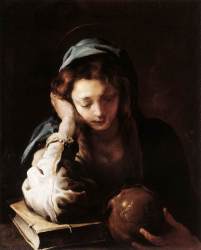 Read the Introduction of the Gospel of Mary Magdalene, pages1 thru 21.
Read the Introduction of the Gospel of Mary Magdalene, pages1 thru 21.
Mary Magdalene by Domenico Fetti (or Feti). For more on the painting at left,mouse over it, and then click here.(Nice info blurb. Mentions the artist’s sister was a painter of good enough quality to make an exact copy of this work sometime before 1621)
We are studying an ancient Gospel written by a woman in the Coptic language
The modern Egyptians speak Arabic, a language from the deserts of Arabia that came up when Islam did. But 20 percent of Egypt’s population still hark back to the original Egyptians who didn’t convert to Islam — they are the Copts and are called Coptic Christians. When the Arabs arrived in Egypt 1400 years ago, the Copts struck a deal with them and were able to keep their identity and their vast Christian network of churches. Unfortunately with the spread of fundamentalist Islam (of the Saudi Arabian variety, which is of course where Islam came from in the first place) the Coptic Egyptians have been persecuted recently by the dominant Arabic rulership of Egypt and their population is dwindling. Many (as in the formerly Christian majority Lebanon) have been chased out to other countries. Some come to the United States, others to South America and Australia. It’s sad because they are the people directly descended from the time of the Pharoahs. If you meet them their faces look like they stepped straight off of an Egyptian wall painting! In Cairo I had a long conversation with a teenage Coptic boy who looked like King Tut wearing a gold christian cross, and then his sister came up and I thought of Nefertiti. In the USA they attend Orthodox Churches, so Russian and Greek Orthodox worshipers know them well. The distant ancestors of the Copts gave up their Isis-Horus-Osiris religion and embraced Christianity just after the time of Yeshua. It was 600 years before the Arabs swept in from the south. The Copts are some of the oldest Christians in the world. They can pick up a copy of the Gospel of Mary Magdalene by Leloup and read the Coptic pages (in part 1) with ease!
After reading the Introduction, please answer the following questions. Cut and paste them into an email, insert your answers and send to the AbbeyCouncil with the subject line: “GMM Lesson 2 from ____________ (your magikal name)”
1. What are the three different ways people see Yeshua the Galilean teacher as given at the bottom of the first page of the introduction?
2. What is the root of the word Coptic? So it really means “Egyptian language”, right?
3. Who says Miriam of Magdala is the founder of Christianity and why?Too bad we weren’t taught that in Sunday School.
4. What intriguing titles does the author give to Yeshua of Nazareth on page 4 and top of page 5? (He calls Yeshua five things on those pages,list at least three).
5. W.C. Till places the Gospel of MM to what year? True or False:This makes it one of the founding or primitive texts of Christianity.
6. Christian authorities have been ignoring this Gospel for years! Some even suppressing it. Leloup says, “The ___________ of ____________ of this text turns out to be one of the most interesting things about it.”
7. How does Leloup use the word anthropology throughout this book? (see p. 7)
8. The Pistis Sophia evolved out of what original ancient book? Sadly Mary Magdalene’s authoritativeness was lost in that evolution and she is strangely minimized and _______ in the Pistis Sophia. The Pistis Sophia can be found online. It is an interesting read but MM has definitely been changed and the sacred feminine is portrayed almost as silly and naive. But at least we have it.
9. Explain why Yeshua could not be a redeemer in the full sense of the word if he had not lived his sexuality.
10. Explain how Westerners ended up with a guilt-ridden sexuality and a religion based on death rather than life.
11. Footnote 17 on page 14 says the Jesus probably spoke only Aramaic. True or False?
12. Footnote 18 on page 14 says that SOUL (to the ancients) is made up of what aspects of the human?
13. The same footnote says Nous and Pneuma are the two ingredients of SPIRIT. Which of the two is closest to SOUL?
14. A living deity who wants to communicate necessitates what? (p.15)
15. The language of sacred scriptures is one of images and symbols. Where else do we find some of these images and symbols?
16. Based on the description given on page 18 do you have (or did you have) a divine, physical or spiritual lover? What kind do you prefer?
17. Exercise: Check out the websites given at the bottom of page21.
Questions by Katia Prioress

